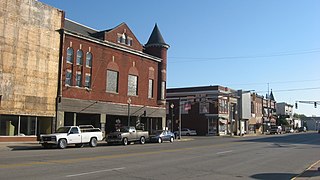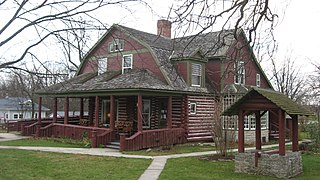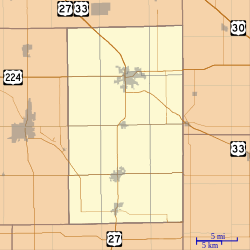
Anderson Downtown Historic District is a national historic district located at Anderson, Madison County, Indiana. The district dates from c. 1887-1955 and encompasses 32 contributing buildings in the central business district of Anderson. Despite some loss of integrity due to demolition and alteration, the district still includes a significant collection of historic and architecturally distinguished commercial buildings. Aside from the usual historic commercial impact of similar districts, this district includes several properties that illustrate Anderson's transportation heritage. Included in the district or nearby are the following individual sites on the National Register of Historic Places: Paramount Theatre, Tower Hotel, Anderson Bank Building, Gruenewald House, and The Anderson Center for the Arts. Additional notable or interesting buildings include the Union Building, the State Theater, the Central Christian Church, the Anderson YMCA, the old post office and the Big Four.

The Elwood Downtown Historic District is a national historic district located at Elwood, Madison County, Indiana. The district encompasses 51 contributing buildings and 1 contributing object in the central business district of Elwood. It developed between about 1887 and 1952, and includes notable examples of Late Victorian, Romanesque Revival, Neoclassical, and Art Deco style architecture. Notable buildings include the Calloway Block, Dehority Block (1894), St. Joseph Catholic Church (1899), United Methodist Church (1899), U.S. Post Office (1911), Carnegie Library (1901), former Elwood City Hall (1899), the Leeson's Building, and the Opera House.

The Knightstown Historic District is national historic district located at Knightstown, Henry County, Indiana. It is roughly bounded by Morgan, Adams, Third, and McCullum Streets and encompasses 536 contributing buildings. It developed between about the 1830s and 1936, and includes many excellent examples of Italianate, Greek Revival, and Gothic Revival styles of architecture. Notable sites of interest include the Knightstown Academy, Elias Hinshaw House, and the Knightstown Public Square. Other notable buildings include the Friends Church (1874-1875), Bethel Presbyterian Church (1885), Christian Church (1882), IOOF Building (1897-1898), Masonic Hall (1900-1901), Lehmanowsky House, Morgan Building (1866-1867), Old Town Hall (1892), Knightstown Public Library (1912), and U.S. Post Office (1936).

The Rochester Downtown Historic District is a historic district on the National Register of Historic Places (NRHP) in Rochester, Indiana, United States. It was placed on the Register on June 24, 2008. The majority of buildings in the area are masonry and Italianate while structures outside the district are largely residential frame built structures.

Gene Stratton-Porter Cabin, , known as the Limberlost Cabin and the Limberlost State Historic Site, was the former home of Gene Stratton Porter, a noted Indiana author who lived in the home from 1895 to 1913. The two-story, fourteen-room log cabin is located near the Limberlost Swamp on the outskirts of Geneva in Adams County, Indiana. Stratton-Porter designed the Queen Anne-style rustic home with the help of an architect. It was listed on the National Register of Historic Places in 1974.

Clay County Courthouse is a historic courthouse located at Brazil, Clay County, Indiana. It was designed by noted Indiana architect John W. Gaddis and built in 1914 in the Classical Revival style. It is a three-story, limestone building over a raised basement. It features a multi-tiered parapet with clock faces within a decorative tympanum and a two-story dome atop the flat roof. The interior has a rotunda with stained glass octahedral dome.

Downtown Auburn Historic District is a national historic district located at Auburn, DeKalb County, Indiana. The district encompasses 52 contributing buildings in the central business district of Auburn. The district developed between about 1870 and 1935, and includes notable examples of Victorian, Classical Revival, Romanesque Revival, and Colonial Revival style architecture. Notable buildings include the DeKalb County Courthouse (1911-1914), Henry Opera House (1917), DeKalb County Jail (1918), Commercial Club (1917), Auburn City Hall (1913), South Interurban Station, Dilgard Building, Y.M.C.A. Building (193-1914), Auburn Hotel (1922), U.S. Post Office (1934), and Masonic Temple.

Downtown Butler Historic District is a national historic district located at Butler, DeKalb County, Indiana. The district encompasses 30 contributing buildings in the central business district of Butler. The district developed between about 1860 and 1950, and includes notable examples of Italianate and Early Commercial style architecture. Notable buildings include the Butler Carnegie Library (1916), Marshall Clothing Company, Old Dimestore (1863), First National Bank Building (1913), Butler Hotel (1914), Oberlin Building (1907), Towne Hardware / Broadway Cafe Buildings (1880s), Thompson Block (1903), and Mutzfeld Building (1912).

Green Block, also known as the Smith Frye Building, is a historic commercial building located in Elkhart, Elkhart County, Indiana. It was built in 1895, and is a two-story, eclectic Italianate style brick commercial building. It features projecting pressed metal bays above each storefront and at the corners and arched second story openings with balconies.

Elkhart Downtown Commercial Historic District is a national historic district located at Elkhart, Elkhart County, Indiana. The district encompasses 59 contributing buildings in the central business district of Elkhart. It was developed between about 1868 and 1930, and includes notable examples of Italianate, Queen Anne, and Classical Revival style architecture. Located in the district are the separately listed Green Block, Lerner Theatre, and Young Women's Christian Association. Other notable buildings include the Cornish Block, Franklin Street Station (1895), Menges Building (1908), former Post Office (1905), Midwest Museum of Modern Art (1922), Elkhart Water Company, Masonic Temple, Rowe Block (1900), and Dreves Building.

Marion Downtown Commercial Historic District is a national historic district located at Marion, Grant County, Indiana. It encompasses 52 contributing buildings, 2 contributing structures, and 1 contributing object in the central business district of Marion. It developed between about 1870 and 1942, and includes notable examples of Italianate, Romanesque, and Classical Revival style architecture. Located in the district is the separately listed Grant County Jail and Sheriff's Residence. Other notable buildings are the Grant County Courthouse (1881–1883), Marion Bank Building, Iroquois Building, Dan-Mar Apartments, United Telephone Block, Cecelian Apartments, Marion Post Office, and William Smith Building / Mecca Club.

Sheridan Downtown Commercial Historic District is a national historic district located at Sheridan, Hamilton County, Indiana. It encompasses 38 contributing buildings and 1 contributing structure in the central business district of Sheridan. It developed between about 1880 and 1939, and includes notable examples of Italianate and Romanesque Revival style architecture. Notable buildings include the H.J. Thistlethwaite Building (1886), Carnegie library, First Christian Church (1910-1911), Higbee Buggy Company, American State Bank (1914), Stanley Brothers Building, Slliot's Drugstore, Indiana Telephone Company building, and U.S. Post Office (1939-1940).

Conner Street Historic District is a national historic district located at Noblesville, Hamilton County, Indiana.

Vincennes Historic District is a national historic district located at Vincennes, Knox County, Indiana. The district encompasses 1,161 contributing buildings, 5 contributing sites, 9 contributing structures, and 37 contributing objects in the central business district and surrounding residential sections of Vincennes. It developed between about 1787 and 1955, and includes notable examples of Federal, Greek Revival, Italianate, and Classical Revival style architecture. Located in the district are the separately listed George Rogers Clark National Historical Park, William Henry Harrison Home, Indiana Territorial Capitol, Old State Bank, and St. Francis Xavier Cathedral and Library. Other notable buildings include the Brouillet House, Knox County Courthouse (1873), Ellis Mansion, Lacy House, Dunn House (1840), Summers House, Fyfield House (1860), Grannan House, Cauthorn House, Gimble-Bond Store (1879), and Rabb House.

Plymouth Downtown Historic District is a national historic district located in Plymouth, Marshall County, Indiana, United States. The district encompasses 47 contributing buildings and one contributing structure in the central business district of Plymouth. It developed between about 1870 and 1940, and includes examples of Italianate, Romanesque Revival, and Colonial Revival style architecture. Located in the district is the separately listed Plymouth Fire Station. Other notable buildings include the Montgomery Ward Building (1929), Metsker Block, Rentschler Building (1910), Early Plymouth Post Office (1884), First National Bank-Plymouth City Hall, Packard Bank Block (1879), Simons Building (1895), Wheeler Block, Bank Block, Bank Block-Masonic Temple (1901), Plymouth Post Office (1935), and Plymouth Motor Sales (1929).

Ellettsville Downtown Historic District is a national historic district located at Ellettsville, Monroe County, Indiana. The district encompasses 50 contributing buildings in the central business district and surrounding residential sections of Ellettsville. It developed between about 1840 and 1953, and includes notable examples of Queen Anne, Early Commercial, Gothic Revival, and Bungalow/American Craftsman style architecture. Notable buildings include the Robert Stimson House, May Presley House, Bradford House, George W. Fletcher House, Wickens House (1909), Capt. Gilbert Perry House, I.O.O.F. Building, Town Hall (1927), Masonic Building (1895), Knights of Pythias Building, First United Methodist Church (1900), and First Baptist Church (1909).

Ellsworth Historic District, also known as Ellsworth Addition, is a national historic district located at Lafayette, Tippecanoe County, Indiana. The district encompasses 144 contributing buildings, 1 contributing site, and 4 contributing structures in a predominantly residential section of Lafayette. It developed between about 1844 and 1936 and includes representative examples of Italianate, Second Empire, Queen Anne, and Bungalow / American Craftsman style architecture. Located in the district are the separately listed Falley Home, Moses Fowler House, and Temple Israel. Other notable buildings include the Second Presbyterian Church (1894-1895), Alexander House, Ball Brothers House, Falley Townhouse, Home Block, Annie Fowler House, and Duplex Townhouse.

Highland Park Neighborhood Historic District is a national historic district located at Lafayette, Tippecanoe County, Indiana. The district encompasses 240 contributing buildings, 1 contributing site, and 1 contributing structure in a planned residential subdivision of Lafayette. It developed between about 1892 and 1945 and includes representative examples of Queen Anne, Tudor Revival, and Bungalow / American Craftsman style architecture. Notable contributing resources include the Blistain Axel Merritt House (1914), John Wagner Jr. House, John Ross House, and Bicycle Bridge (1924).

Ninth Street Hill Neighborhood Historic District is a national historic district located at Lafayette, Tippecanoe County, Indiana. The district encompasses 88 contributing buildings and 6 contributing structures in a predominantly residential section of Lafayette. It developed between about 1850 and 1946 and includes representative examples of Gothic Revival, Italianate, Queen Anne, Greek Revival, and Second Empire style architecture. Located in the district is the separately listed Judge Cyrus Ball House. Other notable contributing resources include the Samuel Moore House (1891), Moore-Porter-Boswell House (1895), Stanley Coulter House (1890), Edward Bohrer House (1909), Thomas Wood House, Job M. Nash House (1859), and Gordon Graham House.

Downtown Wabash Historic District, also known as the Wabash Marketplace District, is a national historic district located at Wabash, Wabash County, Indiana. It encompasses 27 contributing buildings in the central business district of Wabash. It developed between about 1840 and 1920, and includes representative examples of Italianate, Romanesque Revival, and Second Empire style architecture. Located in the district are the separately listed James M. Amoss Building and Solomon Wilson Building. Other notable buildings include the E.M. Conner Building (1897), Back Saddlery and Harness Shop (1845), Wabash Loan and Trust Company (1927), Bradley Block (1901), Busick Block (1882), Eagles Building (1906), the Plain Dealer Building (1897), S.J. Payne Block (1898), J.C. Penney's (1920), National Block (1876), Sheriff's House and Jail (1879), Memorial Hall (1899), U.S. Post Office (1911-1912), Wabash County Courthouse (1878), Shively Block (1897), and Wabash City Hall (1883-1884).

























